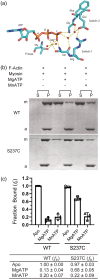Switch-1 instability at the active site decouples ATP hydrolysis from force generation in myosin II
- PMID: 33381891
- PMCID: PMC7986744
- DOI: 10.1002/cm.21650
Switch-1 instability at the active site decouples ATP hydrolysis from force generation in myosin II
Abstract
Myosin active site elements (i.e., switch-1) bind both ATP and a divalent metal to coordinate ATP hydrolysis. ATP hydrolysis at the active site is linked via allosteric communication to the actin polymer binding site and lever arm movement, thus coupling the free energy of ATP hydrolysis to force generation. How active site motifs are functionally linked to actin binding and the power stroke is still poorly understood. We hypothesize that destabilizing switch-1 movement at the active site will negatively affect the tight coupling of the ATPase catalytic cycle to force production. Using a metal-switch system, we tested the effect of interfering with switch-1 coordination of the divalent metal cofactor on force generation. We found that while ATPase activity increased, motility was inhibited. Our results demonstrate that a single atom change that affects the switch-1 interaction with the divalent metal directly affects actin binding and productive force generation. Even slight modification of the switch-1 divalent metal coordination can decouple ATP hydrolysis from motility. Switch-1 movement is therefore critical for both structural communication with the actin binding site, as well as coupling the energy of ATP hydrolysis to force generation.
Keywords: RRID:SCR_002285; RRID:SCR_006643; hydrolase; kinetics; molecular motor.
© 2021 The Authors. Cytoskeleton published by Wiley Periodicals LLC.
Figures




References
-
- Brizendine, R. K. , Sheehy, G. G. , Alcala, D. B. , Novenschi, S. I. , Baker, J. E. , & Cremo, C. R. (2017). A mixed‐kinetic model describes unloaded velocities of smooth, skeletal, and cardiac muscle myosin filaments in vitro. Science Advances, 3(12), eaao2267. 10.1126/sciadv.aao2267 - DOI - PMC - PubMed
Publication types
MeSH terms
Substances
LinkOut - more resources
Full Text Sources
Other Literature Sources

